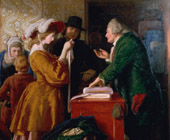 The theory of just price is often misrepresented by those who oppose the idea. They like to say that including justice as a factor in the determining of prices is contrary to free markets. They imagine just price to mean the setting up of an economic tyranny where prices were set in stone and merchants forced to sell a set price.
The theory of just price is often misrepresented by those who oppose the idea. They like to say that including justice as a factor in the determining of prices is contrary to free markets. They imagine just price to mean the setting up of an economic tyranny where prices were set in stone and merchants forced to sell a set price.
The real justice price theory was much more flexible and amazingly in line with free markets.
Norwegian economist Odd Langholm lists eight ways the value of a commodity could be approached according to medieval just price theory:
1. By reference to the common estimate by merchants who deal in the same good or in similar goods;
2. To what the good in question is usually sold for;
3. To labor, industry, care and expenses incurred in transport;
4. To the volume and variety of such goods or their scarcity;
5. To improvement and storage;
6. To their usefulness to the community;
7. To legal statutes and custom.
 It is also interesting to note that just price theory usually applied only to basic commodities and not to luxury items.
It is also interesting to note that just price theory usually applied only to basic commodities and not to luxury items.
(The eight ways were taken from: Odd Langholm, The Merchant in the Confessional: Trade and Price in the Pre-Reformation Penitential Handbooks, Leiden; Boston: Brill, 2003, p. 98.)


